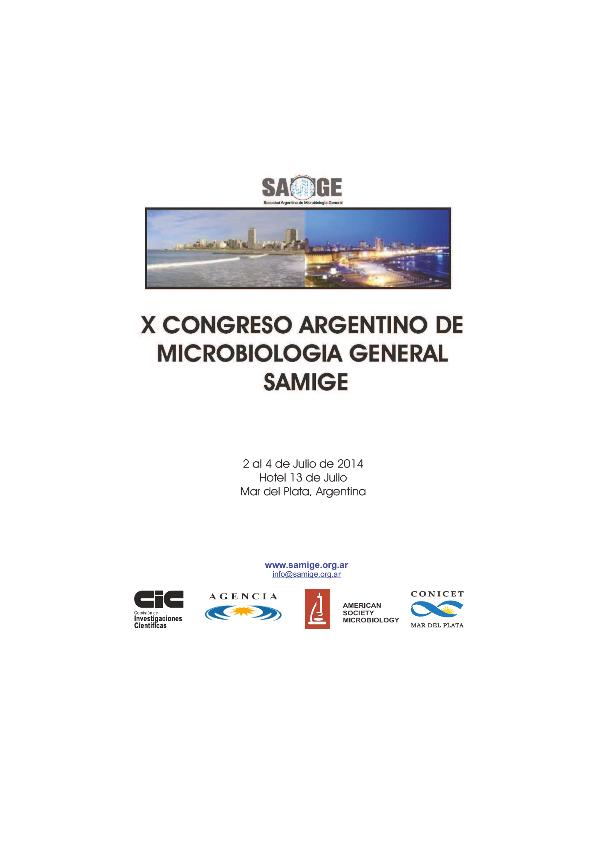Mostrar el registro sencillo del ítem
dc.contributor.author
Regner, Erika Lucía

dc.contributor.author
Baigori, Mario Domingo

dc.contributor.author
Pera, Licia Maria

dc.date.available
2023-03-13T13:19:46Z
dc.date.issued
2014
dc.identifier.citation
Screening de residuos agro-industriales para la producción de una Actividad lipasa asociada al micelio de aspergillus niger mya 135 por Fermentación sumergida; X Congreso Argentino de Microbiología General; Mar del Plata; Argentina; 2014; 1-2
dc.identifier.uri
http://hdl.handle.net/11336/190300
dc.description.abstract
Bioconversion of agricultural wastes for enzymes production is turning in an interesting approach in industrial biotechnologies, mainly in developing countries. Lipases (EC 3.1.1.3) are important industrial enzymes due to their versatile applications. Lipases catalyze a variety of reactions, such as partial or complete hydrolysis of triacylglycerols and reactions of esterification, transesterification and interesterification of lipids. Despite the great interests in the application of lipases in various industries, their high costs of production often restrict their use as biocatalysts. One of the research areas involving lipases currently focuses on the use different microorganisms, supplements and substrates to find the best combinations to obtain high-value lipases using operational conditions that facilitate the reduction of the production costs at industrial scale. This can be achieved through the use of low cost culture media, especially residues from agro-industry so that production can become economically viable. Furthermore, several studies have reported the utilization of microorganisms such as bacteria, yeast and fungi as whole-cell biocatalysts in attempts to improve the cost-effectiveness of the bioconversion processes. Among the established whole-cell biocatalyst systems, filamentous fungi have arisen as the most robust whole-cell biocatalyst for industrial applications. The aim of this work was to analyze the production of a lipase activity from A. niger MYA 135 including the use of agro-industrial residue wastes as components in a culture medium through a statistical experimental design. These experimental layouts can be adopted at various phases of an optimization process, such as for screening experiments or for finding the optimal conditions for targeted effects. One of the most frequently used choices as screening tool in statistical design is the Plackett–Burman. Among the factors analyzed in this design were included agro-industrial wastes such as cane molasses, vinasse, glycerol, waste cooking oil. In these experiments, all analyzed variables had a significant effect on the hydrolytic activity using p-nitrophenyl palmitate as substrate. The waste cooking oil showed the most positive incidence (E= 194.82). However, molasses (E= 102.11) and vinasse (E= 131.40) also had an important positive effect on the response studied. Interestingly, in the most of the analyzed media, we found a promising activity increment as compared to the activity previously reported for this strain. On the other hand, some morphological aspects of the biomasses were also analyzed since it is well known that biotechnological production processes performed with filamentous fungi are dependents of morphology control. Finally, the study presented here demonstrates the feasibility of agro-industrial wastes utilization as a sustainable green technology in the lipase activity production.
dc.format
application/pdf
dc.language.iso
spa
dc.publisher
Sociedad Argentina de Microbiología General
dc.rights
info:eu-repo/semantics/openAccess
dc.rights.uri
https://creativecommons.org/licenses/by-nc-sa/2.5/ar/
dc.subject
Lipasa asociada al micelio
dc.subject
Aspergillus niger
dc.subject
Residuos agro-industriales
dc.subject
Plackett-Burman
dc.subject.classification
Bioprocesamiento Tecnológico, Biocatálisis, Fermentación

dc.subject.classification
Biotecnología Industrial

dc.subject.classification
INGENIERÍAS Y TECNOLOGÍAS

dc.title
Screening de residuos agro-industriales para la producción de una Actividad lipasa asociada al micelio de aspergillus niger mya 135 por Fermentación sumergida
dc.title
Screening of agro-industrial wastes to produce a whole-cell lipase activity by Aspergillus niger MYA 135 under submerged fermentation
dc.type
info:eu-repo/semantics/publishedVersion
dc.type
info:eu-repo/semantics/conferenceObject
dc.type
info:ar-repo/semantics/documento de conferencia
dc.date.updated
2023-03-08T14:57:46Z
dc.journal.pagination
1-2
dc.journal.pais
Argentina

dc.journal.ciudad
Buenos Aires
dc.description.fil
Fil: Regner, Erika Lucía. Consejo Nacional de Investigaciones Científicas y Técnicas. Centro Científico Tecnológico Conicet - Tucumán. Planta Piloto de Procesos Industriales Microbiológicos; Argentina
dc.description.fil
Fil: Baigori, Mario Domingo. Consejo Nacional de Investigaciones Científicas y Técnicas. Centro Científico Tecnológico Conicet - Tucumán. Planta Piloto de Procesos Industriales Microbiológicos; Argentina
dc.description.fil
Fil: Pera, Licia Maria. Consejo Nacional de Investigaciones Científicas y Técnicas. Centro Científico Tecnológico Conicet - Tucumán. Planta Piloto de Procesos Industriales Microbiológicos; Argentina
dc.relation.alternativeid
info:eu-repo/semantics/altIdentifier/url/https://samige.org.ar/wp-content/uploads/2022/10/LIBRO-SAMIGE-2014.pdf
dc.conicet.rol
Autor

dc.conicet.rol
Autor

dc.conicet.rol
Autor

dc.coverage
Internacional
dc.type.subtype
Congreso
dc.description.nombreEvento
X Congreso Argentino de Microbiología General
dc.date.evento
2014-07-02
dc.description.ciudadEvento
Mar del Plata
dc.description.paisEvento
Argentina

dc.type.publicacion
Book
dc.description.institucionOrganizadora
Sociedad Argentina de Microbiología General
dc.source.libro
X Congreso Argentino de Microbiología General
dc.date.eventoHasta
2014-07-04
dc.type
Congreso
Archivos asociados
